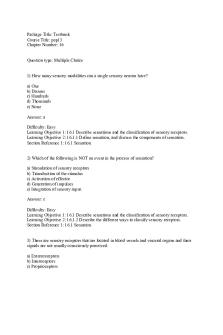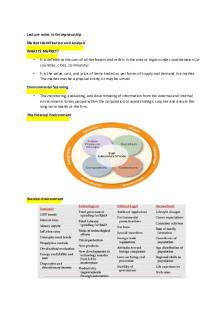Notes Ch 16 Outcome Identification and Planning PDF

| Title | Notes Ch 16 Outcome Identification and Planning |
|---|---|
| Course | Nursing Skills I |
| Institution | South Texas College |
| Pages | 3 |
| File Size | 127.5 KB |
| File Type | |
| Total Downloads | 59 |
| Total Views | 119 |
Summary
Nursing Fundamentals on Idenitifcation and Planning...
Description
Chapter 16 – Outcome Identification and Planning Key Concepts
During the outcome identification and planning steps of the nursing process, the nurse works in partnership with the patient and family to establish priorities, identify and write expected patient outcomes, select evidencebased nursing interventions, and communicate the plan of nursing care. A patient outcome is an expected conclusion to a patient health problem or, with a wellness diagnosis, an expected conclusion to a patient’s health expectation. The nurse, patient, and family should work together as much as possible in the outcome identification and planning stage. If the outcomes specified in the plan of care are not valued by the patient or do not contribute to the prevention, resolution, or reduction of the patient’s problems or the achievement of the patient’s health expectations, the plan of care may be ineffective. The primary purpose of the outcome identification and planning step of the nursing process is to design a plan of care with and for the patient that, once implemented, results in the prevention, reduction, or resolution of patient health problems and the attainment of the patient’s health expectations, as identified in the patient outcomes. A comprehensive plan of care additionally specifies any routine nursing assistance the patient needs to meet basic human needs (e.g., assistance with hygiene or nutrition) and describes appropriate nursing responsibilities for fulfilling the collaborative and medical plan of care. Successful implementation of each step of the nursing process requires high-level skills in clinical reasoning and excellent interpersonal competence. In acute care settings, three basic stages of planning are critical to comprehensive nursing care: initial, ongoing, and discharge planning. Three helpful guides to facilitate clinical reasoning when prioritizing patient problems are Maslow’s hierarchy of human needs, patient preference, and anticipation of future problems. Outcomes are derived from the problem statement of the nursing diagnosis. For each nursing diagnosis in the plan of care, at least one outcome should be written that, when achieved, demonstrates a direct resolution of the problem. The Nursing Outcomes Classification (NOC) developed by the Iowa Outcomes Project presents the first comprehensive standardized language used to describe the patient outcomes that are responsive to nursing intervention. NOC recommends considering the following factors when selecting outcomes: (1) the type of health concern, (2) the nursing or medical diagnoses, (3) patient characteristics, (4) available resources, (5) patient preferences, and (6) treatment potential. Outcomes may be cognitive, psychomotor, or affective. Other outcome categories include clinical, functional, and quality of life. To be measurable, outcomes should have the following: o Subject: the patient or some part of the patient o Verb: the action the patient will perform o Conditions: the circumstances in or by which the outcome is to be achieved (not every outcome specifies conditions) o Performance criteria: expected patient behavior or other manifestation described in observable, measurable terms o Target time: when the patient is expected to be able to achieve the outcome A nursing intervention is any treatment based on clinical judgment and knowledge that a nurse performs to enhance patient outcomes. There are nurse-initiated, physician-initiated, and collaborative interventions. Efforts to standardize nursing care have taken different forms. Popular past approaches include procedures (1960s), standards of care (1970s), algorithms (1980s), and clinical practice guidelines (1990s). The plan of nursing care (patient care plan) is the written guide that directs the efforts of the nursing team working with patients to meet their health goals. It specifies nursing diagnoses, outcomes, and associated nursing interventions. In most institutions and facilities, the plans of care, regardless of their format, communicate directions for three different types of nursing care: nursing care related to basic human needs, nursing care related to nursing diagnoses, and nursing care related to the medical and interdisciplinary plan of care. Student care plans are often more detailed than those found in practice settings. The aim is to assist students to assimilate each of the five steps of the nursing process.
Terms 1.
clinical pathways (critical pathways, CareMaps): case management tools used to communicate the standardized, interdisciplinary plan of care for a particular group of patients; care guidelines and outcomes are specified for each day of the patient’s stay
2. collaborative interventions: interdependent nursing actions performed jointly by nurses and other members of the health care team 3. computerized plans of nursing care: plans of patient care developed by computer software programs that enable the nurse to call up screens listing causes, goals, and related nursing interventions for nursing diagnoses and medical diagnoses 4. consultation: process in which two or more individuals with varying degrees of experience and expertise deliberate about a problem and its solution 5. criteria: specified behavior; for example, the measurable criteria in a patient goal specifies how the patient must perform the desired behavior 6. discharge planning: systematic process of preparing the patient to leave the health care facility and for maintaining continuity of care 7. expected outcome: specific, measurable criteria used to evaluate whether the patient goal has been met 8. goal: an aim or an end 9. initial planning: planning that addresses each problem listed in the prioritized nursing diagnoses and identifies appropriate patient goals and the related nursing care 10. nurse-initiated intervention: independent nursing actions that involve carrying out nurseprescribed interventions written on the nursing care plan, as well as any other actions that nurses initiate without the direction or supervision of another health care professional and that result from their assessment of patient needs 11. nursing care plan: written guide to direct the efforts of the nursing team as they work with the patient to meet health goals; specifies prioritized nursing diagnoses, patient goals, and nursing orders 12. nursing intervention: any treatment, based on clinical judgment and knowledge, that a nurse performs to enhance patient outcomes; there are nurse-initiated, physician-initiated, and collaborative interventions 13. Nursing Interventions Classification (NIC): first comprehensive, validated list of nursing interventions applicable to all settings that can be used by nurses in multiple specialties and facilitates the work of identifying appropriate interventions 14. Nursing Outcomes Classification (NOC): developed by the Iowa Outcomes Project and presents the first comprehensive standardized language used to describe the patient outcomes that are responsive to nursing intervention 15. ongoing planning: planning carried out by any nurse who interacts with the patient to keep the plan up to date, to facilitate the resolution of health problems, to manage risk factors, and to promote function 16. outcome identification: observation of the patient to demonstrate the resolution of the problems identified by the nursing diagnoses and general problem list, along with the time frame for accomplishing these outcomes
17. patient outcome: expected conclusion to a patient health problem, or in the event of a wellness diagnosis, an expected conclusion to a patient’s health expectation 18. physician-initiated intervention: dependent nursing actions, involving carrying out physicianprescribed orders 19. planning: establish patient goals to prevent, reduce, or resolve the problems identified in the nursing diagnoses and determination of related nursing interventions 20. standardized care plans: prepared plan of care that identifies the nursing diagnoses, patient goals, and related nursing orders common to a specific population (e.g., normal neonates) or problem
Notes
Nursing Diagnoses: Based on priority (highest are those that are the greatest threat to well-being such as compromised airway breathing, circulation, or safety issues such as self-harm.) Standardized Plan of Care: individualized and easier to facilitate when there’s a clear known diagnosis. NIC (Nursing Interventions Classification): groups interventions from basic to complex; physiological basic, complex, behavioral, safety, family, health system, and community. During Outcome Identification and Planning, the nurse establishes priorities, client goals, and outcomes. Nursing Outcome Classification System: computerized information system to classify client outcomes. Algorithm: highly specific with no flexibility Critical Pathway: minimal practice standard for a specific client population Order set: orders from a provider to expedite order process Nursing Care Plan: consists of interventions, diagnoses, and outcomes. When writing Outcomes avoid “know, understand” and use verbs that are not noticeable Outcomes Categorized: - Psychomotor: achievement of new physical skills - Cognitive: increase in knowledge - Affective: changes in values, beliefs, and standards - Clinical: expected status of health issues at certain points in time after treatment Maslow’s Hierarchy of Human Needs 1. Physiologic Needs 2. Safety Needs 3. Love and Belonging Needs 4. Self-esteem Needs 5. Self-actualization Needs...
Similar Free PDFs

Ch. 16 Notes
- 2 Pages

314 ch 16 - Lecture notes 16
- 14 Pages

TAM 2200 Notes Ch. 15 & Ch. 16
- 7 Pages

Ch16 - Lecture notes ch 16
- 44 Pages

Abnormal Psych- Ch. 16 Notes
- 5 Pages

Ch 16 Breasts and Axillae
- 15 Pages

Chapter 16 Examples - Ch 16
- 1 Pages

Identification Evidence Notes
- 7 Pages

Project Identification and Selection
- 69 Pages

Outcome 3
- 4 Pages

Practice Questions ch. 16 and 20
- 14 Pages
Popular Institutions
- Tinajero National High School - Annex
- Politeknik Caltex Riau
- Yokohama City University
- SGT University
- University of Al-Qadisiyah
- Divine Word College of Vigan
- Techniek College Rotterdam
- Universidade de Santiago
- Universiti Teknologi MARA Cawangan Johor Kampus Pasir Gudang
- Poltekkes Kemenkes Yogyakarta
- Baguio City National High School
- Colegio san marcos
- preparatoria uno
- Centro de Bachillerato Tecnológico Industrial y de Servicios No. 107
- Dalian Maritime University
- Quang Trung Secondary School
- Colegio Tecnológico en Informática
- Corporación Regional de Educación Superior
- Grupo CEDVA
- Dar Al Uloom University
- Centro de Estudios Preuniversitarios de la Universidad Nacional de Ingeniería
- 上智大学
- Aakash International School, Nuna Majara
- San Felipe Neri Catholic School
- Kang Chiao International School - New Taipei City
- Misamis Occidental National High School
- Institución Educativa Escuela Normal Juan Ladrilleros
- Kolehiyo ng Pantukan
- Batanes State College
- Instituto Continental
- Sekolah Menengah Kejuruan Kesehatan Kaltara (Tarakan)
- Colegio de La Inmaculada Concepcion - Cebu




